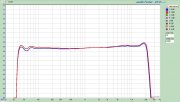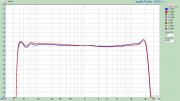I think this is exactly why the deck makers (usually) indicated exactly what tapes the deck was factory set-up for. Use those tapes, and you SHOULD get a flat recording.
But there is always tolerance on everything, including lot-to-lot variability on the same tape.
Now add 40 years of "drift" and "tape ageing" to the mix...
I settled on the SA long (long) ago and have not regretted that decision. Poor storage back in the day and I can still play the tapes I made without the knowledge I currently have and enjoy them. Literally mid-80's recordings done sub-optimally are still listenable. New recordings with all my knowledge, experience and equipment to bear, and it is difficult to discern the tape from a CD source. So, I think that's about all one can hope for with a cassette tape- too narrow a tape moving too slowly across the head.
When I was contemplating making a new deck from scratch, I was FOR SURE going to have the double-speed capability. That one mod solves so many problems with the format.
Of course, as you say.
Set/design the deck recording circuit in order to be flat on the standard tapes... after all, if it does exist a standard then it must be taken into consideration.
I also prefer to tweak the rec circuit to tapes like SA (or Sony UX, same situation) , some good basic ferric (Basf FE-I or Sony HF) and a single coated metal (i.e. Sony Metal XR)... this way, the deck will do a perfect job on the standard tapes and the bright tapes will be slightly bright , which is how they were intended to sound, unless I don't have some tweakable REC EQ (as I did on a couple decks here).
Doing the other way around, i.e. by adjusting the circuit to get flat response from the "bright" tape will result on a treble drop on the response of all the standard tapes, which would make them totally unuseable.
A properly made double speed cassette deck would be a game changer, as the performance will grow by a lot.
Vince, when referring to EQ you mean the time constant, right?
wrong.

I understand equalizations might be confusing... the time constants (70us , 120us) are related to the playback EQ side, where you have to get a standard PB response at those two time constants (or slightly different values to compensate certain kinds of heads).
The playback head works like an inductor, with a response which is (more or less) always rising with frequency by 6dB per octave so, to get a flat playback response, you have to apply a low pass filter with cut off frequencies set according to the 70 and 120 us time constants.
There is also the 3180 us PB time constant which gives some boost around 50Hz to get flat response on the bass side too.
And this is ONLY the playback side.
On the REC EQ side, the situation is totally different and it doesn't really make sense thinking about time constants.
If you try to record a tape without any REC EQ filters (it happened to me, because of a bad solder joint in the REC EQ filters of one channel) you will get a weird response, made mostly of bass, mids and then the response will abruptly roll-off by a whole lot of dBs on the treble side.
In fact, there isn't such a thing like a "standard REC EQ"... and it's not even needed to be standardized.
The REC EQ is, actually, whatever kind of boosting filter which will provide a proper response on a tape of choice, heads of choice and bias setting of choice... so, it's not uncommon to find totally different REC EQ filter arrangements on different decks, since they would be compensating different kinds of heads, bias setting "strategies" and blank tapes of choice.
For example, on my AIWA AD-F880 where I've put amorphous heads and re-designed the whole REC EQ circuit from scratch, to get a flat response, I need to apply some low shelving boost by a few dBs on the bass and low-mids side together which works on a relatively large frequency range with one (sometimes even two) resonant filter centered somewhere on the extreme treble or even over 20Khz which gives a narrow frequency boost peak which can give a very strong boost (like also 20dB of boost at the extreme treble side)...
The effect of both filters together will flatten the recording on a given tape.
Of course, each tape type must have its own REC EQ filter, in fact, when you switch tape types, you will also automatically switch the REC EQ filters.
Just a small bit of patience... as soon as I will have all the detailed data regarding my own modified AD-F880-MAX nicely arranged on the computer, so that I will add more infos on
this thread , this whole matter would be a lot clearer, because I've made quite some heavy work on the REC EQ side, with those 3 switchable settings (3 for each tape type which is a total of 9 different REC EQ filters).

As also put in evidence by Alex in the past, since we are handling more filters together, it's just handy to simulate them with a software like LT Spice... that simulating software was a true lifesaver while doing that work... not sure I could have done it without it.




